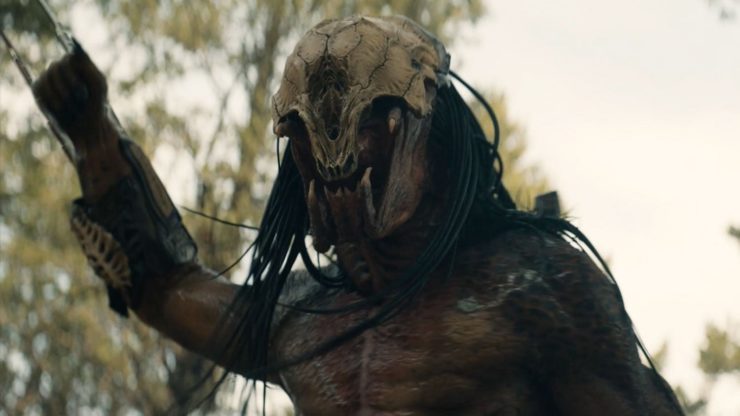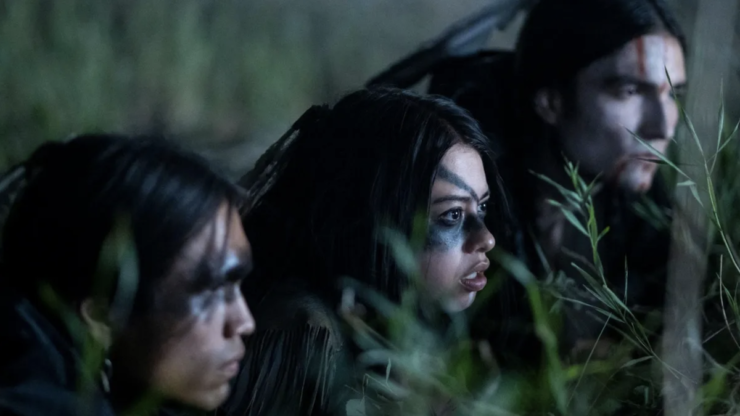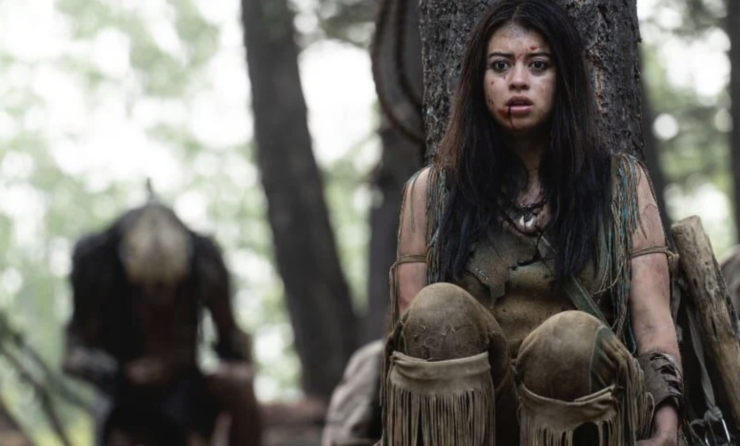Let me say this right off: I checked out of the original Predator (1987) at the arm wrestling. And yes, that means I was a lost cause mere minutes into the film. When the mercenary soldier Dutch (Arnold Schwarzenegger) lays eyes on old friend and CIA operative Dillon (Carl Weathers) and they greet each other with a warrior-bro handclasp that devolves into an impromptu competition for supremacy (and how do you arm wrestle without a table for leverage?), my personal warning flares went up. It was as if the film was saying, Yah, this is what we’re going to be serving up for the next two hours. You want nuance? You want an iconoclastic subversion of jingoistic action cliches? You’ve come to the wrong place, boyo.
[Spoilers for Prey]
The close-up of those two sweaty, ludicrously muscular arms clasped in manly comradeship became iconic, not just for Predator itself, but for an entire genre of hyperbolic action film. But, hell, it was the Eighties. It was a time for Morning in America and getting into dick-waving contests with Russia (something we may be reliving sooner than anyone would like) and for sticking our noses into other country’s politics, whether they belonged there or not. Especially for sticking our noses where they didn’t belong, as had been revealed the previous year with the exposure of Iran-Contra, which Predator not-so-obliquely references through Dutch and team’s mission into the fictional, Central American nation of Val Verde. (which translates roughly to Green Valley—with Arnold presumably their Jolly Giant, ho-ho-ho.)
Buy the Book


Africa Risen
And maybe Predator was offering up some irony in providing a glimpse of the America, Fuck Yeah! spirit getting hoisted by its own petard, the team of mercenaries being pitted against a mammoth, stealth-shielded, highly armed alien whose hobby is hunting down our boys for sport. But if so, the idea got lost in all the violence, macho posturing, and Shane Black’s retrograde sex jokes. To indulge in such introspection would have been wrong for the time, wrong for a cinema awash in Rocky punching Russia in the face and Tom Cruise patrolling the skies in the name of the flag, Mom’s apple pie, and the Super Bowl. (To be fair, if what you wanted was simply a bang-up SF action rave featuring an especially emblematic Stan Winston alien design, then Predator, as befits a film directed by John McTiernan, more than filled the bill. You want to regard it as a classic? Fine. I’m not gonna stand in your way.)
It would take another three-and-a-half decades before we could deconstruct the overt chauvinism of Predator. In between, the franchise would admirably avoid the slavish repetition that curses most sequels, remaking itself with each follow-up. Predator 2 (1990) moved the setting to the urban jungle of a near-future Los Angeles, although by taking a page from Robocop (1987) it ended up confusing social satire with egregious racial stereotyping. Predators (2010) took the franchise off-world, stranding a clutch of morally-compromised humans—including a surprisingly buff Adrien Brody—on what amounted to a private Predator hunting preserve.
Shane Black returned to the franchise, now behind the camera as director and co-writer (along with Fred Dekker), for The Predator (2018), an attempt to revisit the hyper-masculinity of the original, but this time with tongue firmly planted in cheek. To put it mildly, the effort to cast the original’s hyperbolic characterizations in an even more hyperbolic light, along with radically retooling the motivations for the aliens’ hunting spree into some type of Darwinian DNA harvesting program, was not warmly received (although I quite enjoyed it. Shoot me).
(Meanwhile, we’re gonna skip over the two Alien vs. Predator films, which I didn’t watch for this article because… well… because.)

All these movies have their strengths and their weaknesses, but they at least provide enough variation on a theme that the franchise didn’t feel like it was running over the same terrain. But in blazing their own trails, none of the follow-ups—by accident or design—manage to look at those chauvinistic underpinnings that suffuse the first film, nor explore how we’ve risen beyond that as a culture. Not until 2022, and the arrival of Prey.
It’s a prequel, but radical even for that typically accursed genre. Set in 1719 on the Northern Great Plains, its protagonists are not a corps of heavily armed mercenaries but a small tribe of Comanche. The lead character, Naru (Amber Midthunder) is a medicine woman-in-training who actually aspires to hunt alongside the tribe’s males, including her brother Taabe (Dakota Beavers). No brawny dudes here, just a group of subsistence hunters, facing down an alien foe. At that level alone, it’s a compelling contemplation of the nature of predation.
But then, Prey goes further. About midway through, Naru stumbles upon an open field, and a herd of buffalo slaughtered and skinned. We’ve already seen the Predator kill and skin a snake as it works its way up the food chain, so it’s natural to assume that this carnage could be traced back to the alien. (We might also conveniently ignore Naru’s inspection of an odd cylindrical object found near one corpse, while also glossing over our knowledge that Predators tend not to hunt creatures that pose no threat, i.e., large herbivores, i.e. buffalo.) But later on, the Predator itself comes across the killing field, and lingers over the dead creatures—all the way to also inspecting that mysterious cylinder—suggesting that the site is as much of a surprise to the alien as it is to Naru.
And that’s because it is. Not long after, Naru and Taabe are captured by a band of French trappers, a grungy group led by a guy chomping on a fat cigar—the previously seen cylinder. And here’s where Prey pulls the rug out from under the whole basis for the franchise, and the notion of who, exactly, is the alien invader here.
You know that idea that history is written by the victors? Sometimes science fiction is too. Think back on H.G. Wells bringing down his Martian battle machines on cozy, British society, or Independence Day unleashing an alien armada on the American Way. It’s a simple yet powerful formula: Test the dominance of a culture—in many cases largely Anglo, largely white—by pitting it against something stronger. Although Wells was smart enough to have his own society humbled by the conflict, few others have dared to take that leap. Whether it’s Will Smith uploading a computer virus into the aliens’ Apple-compatible system or Gregory Walcott storming a flying saucer to slug a couple of Martians in Plan 9 from Outer Space, the dominant culture remains supreme.

But think on this: Predator’s Arnold Schwarzenegger and his merry band of mercenaries may be surrogates for the whole of American might, but they are also invaders, impinging on another nation’s sovereign territory. Fine enough to imagine what would be the response to an alien incursion when you are the most mega-dominant of all the dominant cultures on Earth. For others, including Native Americans, alien invasions ain’t nothing new. The real-world incarnations of Naru and her people had been dealing with the predations of strange, at times indecipherable adversaries for centuries. As for the film, the choice of who’s the preferable foe, an extra-terrestrial trophy hunter or an unwashed band of poachers, may boil down to a question of degree. The Predator may be hunting for sport (we’re ignoring Shane Black’s revision for the present), but at least it has a code: no pregnant creatures, no children, and only species that are themselves aggressors. The trappers, meanwhile, cage Naru, torture Taabe, and bind the two siblings to a tree as bait for the Predator. That’s better?
It’s of course that moral bankruptcy that is the Frenchmen’s doom: Between the sophisticated tech of the Predator and Naru and Taabe’s raw desire for survival, the trapper’s forces—and I don’t know anything about 18th-century trapping parties, but the Frenchmen’s numbers seem to be just slightly larger than the troops that landed at Normandy—are completely decimated. Naru (START SPOILER) then manages to vanquish the Predator (END. OKAY, NOT THAT MUCH OF A SPOILER), cementing her worthiness as a warrior. Prey in that way is kinder to Indigenous Americans than was reality, where the outcomes of face-offs with invaders rarely fell in the natives’ favor.
And Prey doesn’t ignore that aspect. In returning to her tribe, alien trophy in hand, Naru acknowledges the danger facing them, and urges their relocation to safer ground. The message is clear: Whether at the hands of extraterrestrials or all-too-human usurpers, the Native American nations are in retreat—even in fantasy, history will not be denied.
It’s a fun exercise for an entrenched power to imagine itself challenged by a force greater than its own. For others not as highly positioned on the ladder, the challenge is more than make-believe. Prey scores a moral victory for a culture not subsumed by greed, one that does not indulge in profligate killing. But it doesn’t turn a blind eye to how its alt-reality diverges from harsh history, and what was lost as a result. It’s a great action film, and a stark reminder of a dark legacy.
* * *
Hands down, Prey is my favorite chapter of the Predator franchise. Director Dan Trachtenberg treats his Native American characters with respect (although I doubt they were as skilled in parkour as depicted), and in so doing manages to address everything that bothered me about the original film. But Prey isn’t the only film to subvert the alien invasion scenario by placing it in a setting where us humans don’t have ready access to nuclear arsenals. Attack the Block is one notable example—maybe you know of others. If so, or if you have any other thoughts, objections, or suggestions, the comments section is open for your input. Just remember: Armed conflict should be segregated to the screen. Keep it friendly, keep it fun, and let’s hear your thoughts.
Dan Persons has been knocking about the genre media beat for, oh, a good handful of years, now. He’s presently house critic for the radio show Hour of the Wolf on WBAI 99.5FM in New York, and previously was editor of Cinefantastique and Animefantastique, as well as producer of news updates for The Monster Channel. He is also founder of Anime Philadelphia, a program to encourage theatrical screenings of Japanese animation. And you should taste his One Alarm Chili! Wow!










